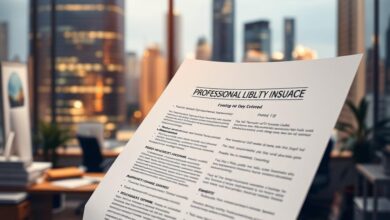Protect Your Business with General and Professional Liability Coverage
As a business owner, you face many risks that could hurt your finances. Liability coverage is key to keeping your business safe from unexpected problems.
Without the right business protection, one lawsuit or accident could cause big financial losses. General and professional liability insurance helps protect your business from these risks. It makes sure your business stays safe.
Key Takeaways
- Liability coverage protects your business from financial losses due to unforeseen circumstances.
- General and professional liability insurance provides a safeguard against lawsuits and accidents.
- Business protection is critical for keeping your finances stable.
- Proper liability coverage ensures your business remains secure.
- Business owners should consider liability insurance to reduce risks.
Understanding Business Liability Risks
In today’s world, knowing about liability risks is key for keeping your business safe. Companies face many risks, like accidents with customers or mistakes by employees.
Common Liability Threats to Modern Businesses
Businesses today deal with many risks. For example, a customer might slip on a wet floor in your store. Or, a client might sue your company for a mistake made by an employee.
The Financial Impact of Uninsured Liability Claims
Not having insurance for liability claims can hurt a lot. Without liability coverage, your business might have to pay a lot for damages and legal fees. This can cause financial problems, harm your reputation, and even close your business.
Why Most Businesses Need Both Types of Coverage
Most businesses need both general and professional liability insurance. General liability covers injuries, property damage, and more. Professional liability protects against mistakes or negligence by employees. Here’s a comparison of these coverages:
| Coverage Type | General Liability Insurance | Professional Liability Insurance |
|---|---|---|
| Coverage for | Bodily injury, property damage, advertising injuries | Professional negligence, errors, and omissions |
| Typical Claims | Slip-and-fall accidents, property damage | Professional mistakes, negligence |
By knowing about these risks and having the right insurance, businesses can protect themselves from big financial losses.
What is General and Professional Liability Insurance?
It’s key for businesses to know about general and professional liability insurance. These insurances help protect against different risks. They keep a company’s money safe and its reputation strong.
General Liability Coverage Explained
General liability insurance guards against claims of injury, property damage, and personal harm. It’s a must for businesses to avoid common risks. This includes accidents on the premises or damage to other people’s property.
For example, if a customer gets hurt in your store, this insurance can help pay for their medical bills and legal costs. It also covers issues like false advertising or copyright problems.
Professional Liability Coverage Breakdown
Professional liability insurance, or errors and omissions insurance, shields against claims of professional mistakes or failure to meet promises. It’s vital for companies that offer professional services or advice.
Let’s say a consultant gives bad advice that causes a client to lose money. This insurance can help pay for the claim costs.
Key Differences and Overlaps Between Policies
General liability insurance deals with broader risks like injury and property damage. Professional liability insurance focuses on professional mistakes. Yet, there can be areas where both policies overlap, like when a professional error causes injury or damage.
Here’s a table to show the differences and where they meet:
| Coverage Aspect | General Liability Insurance | Professional Liability Insurance |
|---|---|---|
| Bodily Injury | Covers customer accidents on premises | Generally not covered unless related to professional services |
| Property Damage | Covers damage to third-party property | May cover if related to professional services or advice |
| Professional Errors | Not covered | Covers negligence, mistakes, or failure to deliver services |
Knowing the specific areas each policy covers and where they overlap helps businesses choose the right insurance. This ensures they’re well-protected against many liability risks.
How to Assess Your Business’s Specific Coverage Needs
Knowing the risks your business faces is essential for the right liability coverage. You need to look at many factors that could affect your business. These factors include how you operate and your financial health.
Analyzing Industry-Specific Risk Factors
Every industry has its own risks. For example, construction sites face accidents, while tech companies worry about data breaches. Knowing the risks in your industry is the first step to figuring out your coverage needs.
Evaluating Business Size and Structure Considerations
The size and setup of your business matter for liability coverage. Bigger businesses or those with complex setups might need more coverage. This is because they have more employees, clients, or projects.
Conducting a Step-by-Step Risk Assessment
To do a good risk assessment, start by finding out what risks you face. Then, see how likely they are and how they could affect you. After that, figure out how to lessen these risks. This process includes:
- Looking at your business operations and finding weak spots.
- Checking how likely and how big of an impact these risks could have.
- Putting in place ways to reduce or handle these risks.
By taking these steps, you can make sure your business has the right liability coverage. This protects it from possible risks.
Essential Components of a General Liability Policy
Understanding the parts of a general liability policy is key to a solid business insurance plan. It guards against risks like property damage and injuries to others.
Property Damage and Bodily Injury Coverage
Property damage coverage is vital. It pays for damage to other people’s property. Bodily injury coverage helps if someone gets hurt on your business premises.
Personal and Advertising Injury Protection
Personal and advertising injury protection is also important. It shields your business from claims about libel, slander, and false ads.
Legal Defense Cost Coverage
Legal defense cost coverage is part of general liability policies. It helps cover the costs of defending against claims.
Coverage Limits and Deductibles
It’s important to know about coverage limits and deductibles. Limits show the max an insurer will pay for a claim. Deductibles are what you pay first before insurance kicks in.
| Coverage Type | Description | Typical Limits |
|---|---|---|
| Property Damage | Covers damage to third-party property | $100,000 – $1 million |
| Bodily Injury | Covers injuries to customers or individuals on premises | $500,000 – $2 million |
| Personal and Advertising Injury | Covers claims related to libel, slander, and false advertising | $100,000 – $1 million |
Critical Elements of Professional Liability Coverage
It’s vital for businesses to know about professional liability coverage. This insurance, also known as errors and omissions insurance, helps protect against claims of negligence or malpractice. It’s a key way to manage risks.
Errors and Omissions Protection
Errors and omissions protection is a core part of professional liability insurance. It shields businesses from claims due to mistakes or omissions in their services. This is very important for professionals like consultants, financial advisors, or IT specialists.
Negligence and Malpractice Coverage
Negligence and malpractice coverage helps professionals face allegations of not doing their job right. It covers legal defense costs, settlements, or judgments.
Claims-Made vs. Occurrence Policies
Professional liability policies can be either claims-made or occurrence-based. Claims-made policies cover claims made during the policy period. Occurrence policies cover incidents that happen during the policy period, even if the claim is made later.
Retroactive Coverage Options
Retroactive coverage is key for businesses with claims-made policies. It ensures coverage for incidents before the policy’s start date. This keeps protection continuous.
| Policy Type | Coverage Period | Retroactive Coverage |
|---|---|---|
| Claims-Made | Policy period | Optional |
| Occurrence | Policy period | Not applicable |
How to Select the Right Insurance Provider
Choosing the right insurance provider is key to protecting your business. You need to think about several important factors. This ensures your business is safe from different risks.
Evaluating Insurance Company Stability and Reputation
It’s vital to check if the insurance company is stable and has a good reputation. A solid company will likely pay out when you need them to.
Check financial ratings from places like A.M. Best or Moody’s. This shows how financially strong the insurer is.
Comparing Policy Terms, Conditions, and Exclusions
Knowing what’s covered and what’s not is critical. Look at the policy’s terms, conditions, and what’s excluded. Make sure it fits your business needs.
- Review coverage limits and deductibles.
- Understand what is excluded from coverage.
- Check for any additional riders or endorsements.
Working with Specialized Business Insurance Agents
Specialized agents can offer great advice. They can customize insurance policies for your business.
Benefits of working with specialized agents include personalized service and deep knowledge of business insurance.
Questions to Ask Before Purchasing Coverage
Before you buy, ask the right questions. Here are some important ones:
| Question | Purpose |
|---|---|
| What does the policy cover? | Understand the scope of coverage. |
| What are the policy limits and deductibles? | Assess the financial implications. |
| Are there any exclusions or limitations? | Identify any gaps in coverage. |
Steps to Implement a Comprehensive Liability Protection Plan
Businesses need to act early to set up a strong liability protection plan. This plan helps keep your finances safe from risks and losses.
Determining Appropriate Coverage Limits for Your Business Size
First, figure out the right coverage limits for your business. Look at your business size, industry, and risks. It’s important to have enough coverage but not too much.
Budgeting for Insurance Costs and Premium Management
Managing your insurance budget well is key. Know what affects your premiums and find ways to keep costs down. Compare insurance providers to get the best deals.
Implementing Risk Management Practices to Lower Premiums
Risk management practices help lower your insurance costs. Use safety measures, train your team, and check for risks often. This way, you can lower your liability and insurance costs.
Regularly Reviewing and Updating Your Coverage
Make sure to regularly review and update your coverage. As your business grows or laws change, your plan should too. This keeps it effective and relevant.
By following these steps and staying proactive, businesses can greatly reduce risks. This ensures a more stable financial future.
Conclusion: Securing Your Business’s Future with Proper Liability Coverage
General and professional liability insurance are key for a solid business protection plan. They help protect your business from financial loss due to lawsuits. By getting the right insurance, you can keep your business safe and growing.
To build a strong liability protection plan, first figure out what your business needs. Then, choose a good insurance provider. Don’t forget to check and update your coverage often. This way, you can avoid big risks and stay safe from unexpected problems.
Investing in liability insurance helps keep your business’s assets safe. It also keeps your customers happy and trusting. Getting the right coverage is a smart move for your business’s future success and stability in today’s market.









